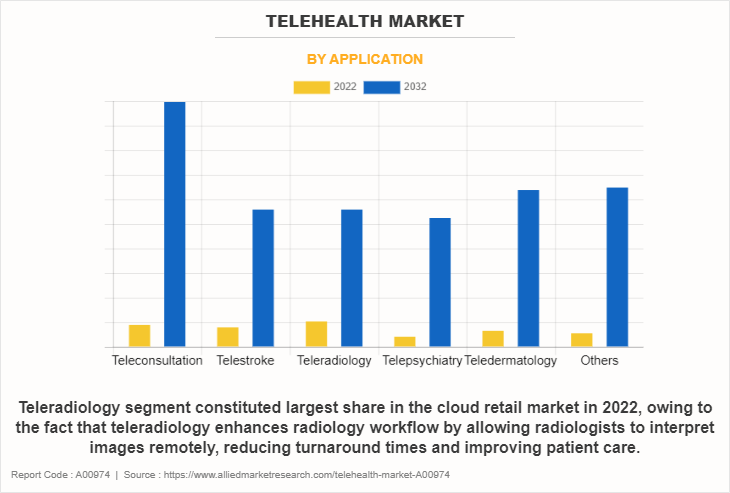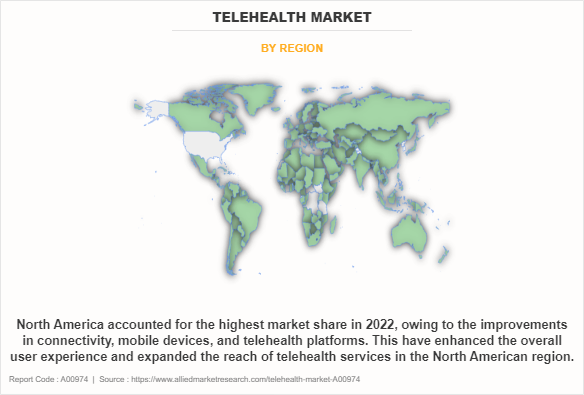Telehealth Market Statistics: 2032
The global telehealth market size was valued at $84.4 billion in 2022, and is projected to reach $784.3 billion by 2032, growing at a CAGR of 25.2% from 2023 to 2032.
The key factors that drive the growth of the telehealth market include growing use of web-and cloud-based platforms and increase in healthcare digitalization activities and government initiatives. The launch of the web and cloud-based platforms, which provide virtual care to users, are anticipated to increase the industry growth. Web and cloud-based platforms offer the scalability needed to accommodate the increasing demand for telehealth services.

As more patients and healthcare providers embrace telehealth, cloud infrastructure can seamlessly expand to meet these demands. In addition, increased patient engagement is considered an important factor to boost the telehealth market. However, lack of training and education is expected to hamper market growth. Telehealth systems or tools are technologically advanced and can be complicated to manage. Thus, healthcare professionals may require specific training and education to effectively utilize telehealth tools or platforms.
A lack of knowledge or training might hinder the full utilization of telehealth capabilities. Contrarily, increase in incidence of cancer cases globally contribute significantly to the growth of the market. Telehealth allows patients to consult with oncology specialists, regardless of their geographic location. This is particularly valuable for patients in regions with a shortage of specialized healthcare providers. Therefore, these factors are expected to drive the growth of telehealth market in upcoming years.
Telehealth refers to the use of digital communications technology to deliver healthcare services remotely. This includes a wide range of services and applications that use telecom equipment to facilitate remote medical advice, diagnosis, treatment, monitoring and healthcare services, such as video conferencing, mobile apps and secure messaging.
The report focuses on growth prospects, restraints, and trends of the telehealth market analysis. The study provides Porter’s five forces analysis to understand the impact of various factors, such as bargaining power of suppliers, competitive intensity of competitors, threat of new entrants, threat of substitutes, and bargaining power of buyers, on the telehealth market.
Top Impacting Factors
Increase in Healthcare Digitalization Activities and Government Initiatives
The increase in healthcare digitalization activities and government initiatives has been a significant force in reshaping the healthcare landscape. The adoption of electronic health records (EHRs) systems has revolutionized healthcare record-keeping. Digital records are easily accessible, reducing errors, and enabling healthcare providers to make more informed decisions about patient care. Moreover, digitalization supports a shift towards patient-centered care. Patients have access to their health records, can communicate with healthcare providers online, and actively participate in their healthcare decisions.
In addition, growing healthcare digitalization activities and increasing government initiatives in remote patient monitoring are expected to increase the market's growth over the upcoming years. Increasing campaigns by the government and non-governmental organizations for the high use of telehealth and remote patient monitoring services for long-term care services is also expected to increase the global telehealth market growth. All these trends drive the growth of the telehealth industry.
Growing Use of web-and Cloud-based Platforms
The launch of the web and cloud-based platforms, which provide virtual care to users, are anticipated to increase the industry growth. Web and cloud-based platforms offer the scalability needed to accommodate the increasing demand for telehealth services. As more patients and healthcare providers embrace telehealth, cloud infrastructure can seamlessly expand to meet these demands. Moreover, cloud platforms enable interoperability by allowing different healthcare systems and applications to exchange data easily. This is crucial for ensuring that patient information is readily available to authorized users, regardless of their location.
In addition, cloud platforms facilitate the integration of IoT devices for remote monitoring of patients' vital signs and health metrics. This data can be analyzed in real time to provide proactive care and early intervention. For instance, in 2021, CVS partnered with Teladoc to launch CVS Health's Aetna Virtual Primary Care. The partnership was done so that CVS Health will use Teladoc's physician network to deliver virtual care services to patients remotely through video consultations, decreasing the patient's dependency on in-person consultations and visits. Thus, this factor boosts telehealth market growth.
Increased Patient Engagement
Telehealth enables patients to access healthcare services from the comfort of their homes or any location. As patients find it easier to engage with healthcare providers through telehealth, the demand for telehealth services increases, driving the market’s growth. Patient engagement encourages individuals to take a more proactive role in managing their health. Through telehealth platforms, patients can access their health data, receive personalized treatment plans and communicate with healthcare professionals. Beyond traditional healthcare services, telehealth services often offer various health and wellness services such as mental counselling and nutrition consultations. These services attract a broader range of patients who are actively engaged in improving their overall well-being. Thus, the increased patient engagement is observed to act as a driver for the telehealth market.
Lack of Training and Education
Telehealth systems or tools are technologically advanced and can be complicated to manage. Thus, healthcare professionals may require specific training and education to effectively utilize telehealth tools or platforms. A lack of knowledge or training might hinder the full utilization of telehealth capabilities. If used in a wrong way, the system or tool may create a wrong outcome for patients. The proper management of such systems is crucial as it handles multiple patient records, data and prescriptions. Thus, lack of training and education about these systems and tools is observed to hinder the telehealth market growth.
Increase in Incidence of Cancer Cases Globally
The telehealth market is anticipated to grow significantly due to the rising cancer incidence globally. The healthcare systems are expected to be stressed by this rising prevalence because there is a shortage of doctors and nurses in most countries, which is expected to increase demand for the services. The WHO estimates that there will be a shortage of 15 billion healthcare workers in facilities by 2030, which will encourage the use of AI for patient treatment and diagnosis, increase accessibility to healthcare services in remote areas and lower healthcare costs.
Moreover, remote patients can receive healthcare services virtually and digitally, thanks to telehealth. The use of technology makes it possible to provide patients with patient-centered care remotely, which lowers the number of hospitalizations and emergency room visits. Furthermore, telehealth allows patients to consult with oncology specialists, regardless of their geographic location. This is particularly valuable for patients in regions with a shortage of specialized healthcare providers. Therefore, these factors are expected to drive the growth of telehealth industry in upcoming years.
Integration of Artificial Intelligence and Machine Learning
Artificial intelligence models can analyze patient data to create personalized treatment plans based on an individual’s unique medical history, genetic makeup and lifestyle factors. This level of personalization can lead to more effective treatments and better patient compliance. AI-powered chatbots and virtual health assistants can offer basic medical advice, answer common health-related questions, and assist patients with managing chronic conditions. This relieves some of the burdens on healthcare providers and enhances patient engagement.
In addition, ML algorithms can assist in medication management by predicting how patients will respond to different medications and dosages, reducing adverse effects and optimizing treatment. Furthermore, AI-powered chatbots and virtual assistants improve the telehealth experience by assisting with appointment scheduling, answering patient queries, and facilitating follow-ups.
Segment Review
The telehealth market is segmented on the basis of component, delivery mode, application, end users, and region. On the basis of component, the market is categorized into hardware, software, and service. On the basis of delivery mode, the market is divided into on-premise, and cloud. On the basis application, the market is segregated into teleconsultation, telestroke, teleradiology, telepsychiatry, teledermatology, and others. On the basis of end users, it is divided into healthcare providers, payers, patients, and others. On the basis of region, it is analyzed across North America, Europe, Asia-Pacific, and LAMEA.

On the basis of application, the teleradiology segment attained the highest telehealth market size in 2022. This is attributed to the fact that teleradiology enhances radiology workflow by allowing radiologists to interpret images remotely, reducing turnaround times and improving patient care. Moreover, teleradiology offers the opportunity to provide specialized subspecialty consultations, catering to complex cases that require expert opinions.

On the basis of region, North America held the highest telehealth market share in 2022. This is due to the improvements in connectivity, mobile devices, and telehealth platforms have enhanced the overall user experience and expanded the reach of telehealth services in the North American region.
The report analyzes the profiles of key players operating in the telehealth market such as Koninklijke Philips N.V., GE HealthCare, Cerner Corporation (Oracle), Siemens Healthcare Private Limited, Medtronic, Teladoc Health, Inc., American Well, MDLIVE, GlobalMedia Group, LLC, and CareCloud, Inc. These players have adopted various strategies to increase their market penetration and strengthen their position in the market.
Market Landscape and Trends
Moreover, with the increasing adoption of smartphones and easy availability of technologically advanced devices, innovators have started investing to make the most of the current situation of the industry, by focusing on delivering quality healthcare & comfort through various mobile platforms, which would help patients track their fitness regimes and obtain answers to medical inquiries over the phone, WhatsApp, or through several mobile applications.
In addition, the telehealth platforms are gaining rapid traction among the consumers owing to the availability of healthcare professional services such as consultations on the press of a button. The rising investments on the development of IT infrastructure and rising adoption of smartphones and internet among the global population is fostering the growth of the telehealth market. Furthermore, the rising number of hospitals and clinics across the globe is boosting the adoption of telehealth. Telehealth keeps a track of patients’ medical health and supplies useful insights to the doctors during the treatment of the patients. This helps the doctors to provide effective treatment to the patients, which is expected to fuel the market growth during the forecast period.
Key Benefits for Stakeholders
This report provides a quantitative analysis of the market segments, current trends, estimations, and dynamics of the telehealth market forecast from 2022 to 2032 to identify the prevailing market opportunities.
Telehealth market research is offered along with information related to key drivers, restraints, and opportunities of telehealth market outlook.
Porter's five forces analysis highlights the potency of buyers and suppliers to enable stakeholders to make profit-oriented business decisions and strengthen their supplier-buyer network.
In-depth analysis of the telehealth market segmentation assists in determining the prevailing telehealth market opportunity.
Major countries in each region are mapped according to their revenue contribution to the global market.
Market player positioning facilitates benchmarking and provides a clear understanding of the present position of the market players.
The report includes an analysis of the regional as well as global telehealth market trends, key players, market segments, application areas, and market growth strategies.
Telehealth Market Report Highlights
| Aspects | Details |
| Market Size By 2032 | USD 784.3 billion |
| Growth Rate | CAGR of 25.2% |
| Forecast period | 2022 - 2032 |
| Report Pages | 485 |
| By Delivery Mode |
|
| By Application |
|
| By End Users |
|
| By Component |
|
| By Region |
|
| Key Market Players | Medtronic, MDLIVE, CareCloud, Inc., American Well Corporation, Siemens Healthcare Private Limited, Cerner Corporation (Oracle), Teladoc Health, Inc., GE Healthcare, GlobalMedia Group, LLC, Koninklijke Philips N.V. |
Analyst Review
Telehealth focuses on providing basic healthcare services to patients with improved safety and quality. Telehealth applications have been able to provide quality care to patients while reducing adverse events and preventing symptoms. Innovations in digital health, such as smart wearables, the internet of things, advanced health analytics, better internet connectivity, and the rise of smartphones are dramatically changing business development, while algorithmic integration through artificial intelligence and machine learning healthcare is becoming more personal. Moreover, the rising number of hospitals and clinics across the globe is boosting the adoption of telehealth. Telehealth keeps a track of patients’ medical health and supplies useful insights to the doctors during the treatment of the patients. This helps the doctors to provide effective treatment to the patients.
The market players have adopted strategies such as product launch for enhancing their services in the market and improving customer satisfaction. For instance, in January 2020, MDLIVE launched virtual primary care platform to enhance patient access. The new platform helped in providing customers with easy, secure, and affordable options for accessing preventive, chronic, and other primary care services. The high-quality dermatological, behavioral health, and urgent care services provided by MDLIVE to more than 36 million members across the country are based on this new solution. Such strategies are anticipated to boost the growth of the telehealth market.
Moreover, some of the key players profiled in the report are Koninklijke Philips N.V., GE HealthCare, Cerner Corporation (Oracle), Siemens Healthcare Private Limited, Medtronic, Teladoc Health, Inc., American Well, MDLIVE, GlobalMedia Group, LLC, and CareCloud, Inc. These players have adopted various strategies to increase their market penetration and strengthen their position in the industry.
The key players profiled in the report include telehealth market analysis includes top companies operating in the market such as Koninklijke Philips N.V., GE HealthCare, Cerner Corporation (Oracle), Siemens Healthcare Private Limited, Medtronic, Teladoc Health, Inc., American Well, MDLIVE, GlobalMedia Group, LLC, and CareCloud.
The telehealth market is estimated to grow at a CAGR of 25.2% from 2023 to 2032.
The telehealth market is projected to reach $784.28 billion by 2032.
Increase in healthcare digitalization activities and government initiatives, growing use of web-and cloud-based platforms, and increased patient engagement contribute towards the growth of the market.
The key growth strategies of telehealth players include product portfolio expansion, mergers & acquisitions, agreements, business expansion, and collaborations.
Loading Table Of Content...
Loading Research Methodology...


